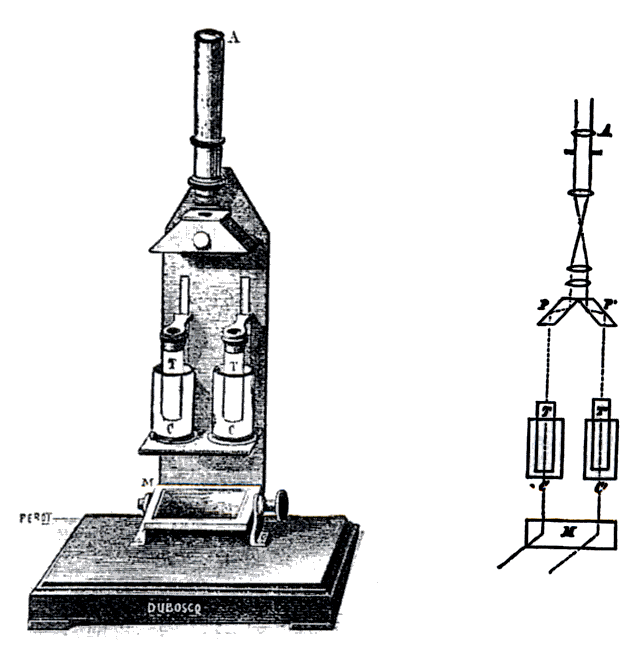Colorimetry (chemical method) on:
[Wikipedia]
[Google]
[Amazon]
 In
In
 In
In physical
Physical may refer to:
*Physical examination
In a physical examination, medical examination, or clinical examination, a medical practitioner examines a patient for any possible medical signs or symptoms of a medical condition. It generally cons ...
and analytical chemistry, colorimetry or colourimetry is a technique used to determine the concentration of colored compounds in solution.
A colorimeter is a device used to test the concentration of a solution by measuring its absorbance of a specific wavelength of light (not to be confused with the tristimulus colorimeter
A tristimulus colorimeter, colloquially shortened to ''colorimeter'', is used in digital imaging to profile and calibrate output devices.
It takes a limited number of wideband spectral energy readings along the visible spectrum by using filter ...
used to measure colors in general).
To use the colorimeter, different solutions must be made, including a control or reference of known concentration. With a visual colorimeter, for example the Duboscq colorimeter illustrated, the length of the light path through the solutions can be varied while filtered light transmitted through them is compared for a visual match. The concentration times path length is taken to be equal when the colors match, so the concentration of the unknown can be determined by simple proportions. Nessler tubes work on the same principle.
There are also electronic automated colorimeters; before these machines are used, they must be calibrated with a cuvette containing the control solution. The concentration of a sample can be calculated from the intensity of light before and after it passes through the sample by using the Beer–Lambert law
The Beer–Lambert law, also known as Beer's law, the Lambert–Beer law, or the Beer–Lambert–Bouguer law relates the attenuation of light to the properties of the material through which the light is travelling. The law is commonly applied t ...
. Photoelectric analyzers came to dominate in the 1960s.
The color or wavelength of the filter chosen for the colorimeter is extremely important, as the wavelength of light that is transmitted by the colorimeter has to be the same as that absorbed by the substance being measured. For example, the filter on a colorimeter might be set to red if the liquid is blue.
Absorption colorimeter
A colorimeter is a device used to test the concentration of a solution by measuring its absorbance of a specific wavelength of light. To use this device, different solutions must be made, and a control (usually a mixture ofdistilled water
Distilled water is water that has been boiled into vapor and condensed back into liquid in a separate container. Impurities in the original water that do not boil below or near the boiling point of water remain in the original container. Thus, dis ...
and another solution) is first filled into a cuvette and placed inside a colorimeter to calibrate the machine. Only after the device has been calibrated you can use it to find the densities and/or concentrations of the other solutions. You do this by repeating the calibration, except with cuvettes filled with the other solutions.
The filter on a colorimeter must be set to red if the liquid is blue. The size of the filter initially chosen for the colorimeter is extremely important, as the wavelength of light that is transmitted by the colorimeter has to be same as that absorbed by the substance.
Colorimetric assays
{{main, Colorimetric analysis Colorimetric assays use reagents that undergo a measurable color change in the presence of theanalyte
An analyte, component (in clinical chemistry), or chemical species is a substance or chemical constituent that is of interest in an analytical procedure. The purest substances are referred to as analytes, such as 24 karat gold, NaCl, water, etc ...
. They are widely used in biochemistry to test for the presence of enzymes, specific compounds, antibodies, hormones and many more analytes. For example,
* para-Nitrophenylphosphate is converted into a yellow product by alkaline phosphatase
The enzyme alkaline phosphatase (EC 3.1.3.1, alkaline phosphomonoesterase; phosphomonoesterase; glycerophosphatase; alkaline phosphohydrolase; alkaline phenyl phosphatase; orthophosphoric-monoester phosphohydrolase (alkaline optimum), systematic ...
enzyme.
* Coomassie Blue once binding to proteins elicits a spectrum shift, allowing quantitative dosage. A similar colorimetric assay, the Bicinchoninic acid assay, uses a chemical reaction to determine protein concentration.
* Enzyme linked immunoassays use enzyme-complexed-antibodies to detect antigens. Binding of the antibody is often inferred from the color change of reagents such as TMB.
See also
*Jules Duboscq
Louis Jules Duboscq (March 5, 1817 – September 24, 1886) was a French instrument maker, inventor, and pioneering photographer. He was known in his time, and is remembered today, for the high quality of his optical instruments.
Life and wo ...
* Permanganometry Permanganometry is one of the techniques used in chemical quantitative analysis. It is a redox titration that involves the use of permanganates to measure the amount of analyte present in unknown chemical samples. It involves two steps, namely the ...
* Lovibond colorimeter
* Turbidimetry
References